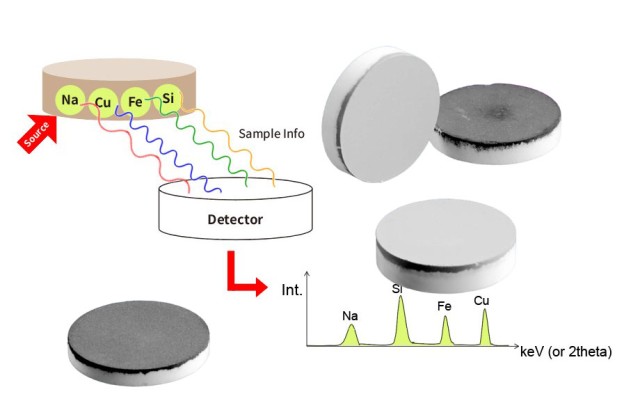목차
XRF 시료 전처리 소개
X선 형광(XRF) 분석 영역에서는 정확하고 신뢰할 수 있는 결과를 얻기 위해 시료 준비의 정밀도가 가장 중요합니다. 이 과정에서 펠렛 프레싱은 샘플을 균질화하여 분석에 사용할 수 있도록 하는 중요한 역할을 합니다. 그러나 부적절한 입자 크기, 오염, 잘못된 바인더 선택, 부적절한 압력 적용과 같은 일반적인 문제는 심각한 오류로 이어질 수 있습니다. 이 문서에서는 펠렛 프레스 XRF 시료 준비에서 가장 빈번하게 발생하는 함정에 대해 자세히 살펴보고 이를 극복하기 위한 실용적인 솔루션을 제공하여 궁극적으로 최고 수준의 정밀도를 달성할 수 있도록 안내합니다.
입자 크기: 성공적인 펠렛 준비의 기초
입자 크기는 압축 펠릿을 준비할 때 중요한 요소로 분석 결과의 정확성과 신뢰성에 큰 영향을 미칩니다. 일반적으로 50µm 미만의 이상적인 입자 크기를 달성하는 것은 여러 가지 이유로 필수적입니다. 첫째, 입자 크기가 작을수록 시료 내 균질성이 향상됩니다. 입자가 너무 크거나 크기가 다양하면 펠릿 내 원소 분포에 불일치가 발생하여 분석 데이터가 왜곡될 수 있습니다.
균일한 입자 크기의 중요성
균일한 입자 크기는 여러 가지 이유로 가장 중요합니다. 입자가 작을수록 펠릿을 눌렀을 때 더 효율적으로 압축하고 결합할 수 있습니다. 이러한 균일성은 시료가 고르게 압축되도록 보장하여 보다 일관되고 신뢰할 수 있는 분석 결과를 제공합니다. 반대로 입자 크기가 크거나 다양하면 펠릿 내에 이질성이 발생하여 펠릿의 다른 영역에 서로 다른 농도의 원소가 포함될 수 있습니다. 이러한 이질성은 분석 장비가 전체 펠릿을 균일하게 샘플링하지 못할 수 있기 때문에 잘못된 판독값으로 이어질 수 있습니다.
이상적인 입자 크기 달성
50µm 미만의 이상적인 입자 크기를 달성하기 위해 다양한 실험실 기법을 사용할 수 있습니다. 일반적인 방법으로는 분쇄기, 분쇄기, 분쇄기를 사용하여 압축하기 전에 시료의 입자 크기를 줄이는 방법이 있습니다. 일반적으로 입자 지름이 40µm 이하인 것이 허용되는 것으로 간주됩니다. 이러한 기술을 통해 시료를 미세하게 분쇄하여 최종 펠릿의 균일성과 일관성을 높일 수 있습니다.
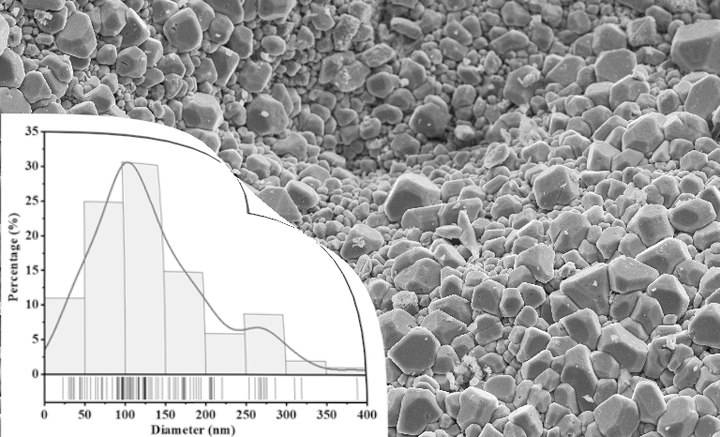
입자 크기가 분석 결과에 미치는 영향
입자 크기가 분석 결과에 미치는 영향은 아무리 강조해도 지나치지 않습니다. 최상의 분석 결과를 제공하는 펠릿을 생산하려면 입자 크기가 작을수록 중요합니다. 예를 들어, X선 형광(XRF) 분석에서 시료 내 원소에 대한 샘플링 깊이 또는 임계 탈출 깊이는 에너지에 따라 달라집니다. 나트륨(Na)과 같은 긴 파장의 원소는 철(Fe)과 같은 짧은 파장의 원소보다 더 작은 탈출 깊이를 가집니다. 즉, Na 분석은 시료의 처음 10µm 정도만 샘플링한다는 의미입니다. 따라서 이 얕은 깊이 내의 이질성은 분석의 정확도에 큰 영향을 미칠 수 있습니다.
반대로 입자 크기가 크거나 다양하면 시료에 이질성이 발생할 수 있습니다. 이러한 이질성으로 인해 펠릿 내 원소 분포가 일관되지 않아 분석 데이터의 신뢰성이 떨어질 수 있습니다. 예를 들어, 펠릿에 입자 크기가 다양한 영역이 포함되어 있는 경우 분석 장비가 이러한 영역을 균일하게 샘플링하지 못해 측정된 원소 농도에 불일치가 발생할 수 있습니다.
입자 크기 제어를 위한 모범 사례
최상의 분석 결과를 얻으려면 입자 크기 제어를 위한 모범 사례를 따르는 것이 필수적입니다. 여기에는 50µm 미만의 균일한 입자 크기를 얻기 위해 적절한 분쇄 및 밀링 기술을 사용하는 것이 포함됩니다. 준비 과정의 세부 사항과 일관성에 대한 주의도 중요합니다. 시료가 이상적인 입자 크기로 분쇄되도록 함으로써 분석가는 이질성의 위험을 최소화하고 보다 정확하고 신뢰할 수 있는 분석 결과를 얻을 수 있습니다.
요약하면, 입자 크기는 성공적인 펠릿 준비의 기초입니다. 50µm 미만의 균일한 입자 크기를 달성하고 유지하는 것은 시료의 균질성을 보장하는 데 매우 중요하며, 이는 결국 보다 정확하고 신뢰할 수 있는 분석 결과로 이어집니다. 분석가는 모범 사례를 따르고 준비 과정에 세심한 주의를 기울임으로써 분석 데이터의 품질을 크게 향상시킬 수 있습니다.
오염: XRF 분석의 소리 없는 방해자
오염은 특히 시료 전처리 과정에서 X선 형광(XRF) 분석에서 가장 중요한 문제 중 하나입니다. 분쇄 단계는 오염이 쉽게 발생하여 부정확하고 잘못된 결과를 초래할 수 있는 중요한 지점입니다. 오염원을 이해하고, 효과적인 예방 방법을 구현하며, 오염의 결과를 인식하는 것은 XRF 분석의 무결성을 유지하는 데 필수적입니다.
오염원
XRF 분석의 오염은 다양한 원인에서 발생할 수 있지만, 특히 연삭 공정이 취약합니다. 분쇄하는 동안 시료 전처리 기기의 외부 구성 요소가 실수로 시료에 유입될 수 있습니다. 이는 시료 사이에 분쇄 도구나 용기를 제대로 세척하지 않아 교차 오염으로 이어질 경우 발생할 수 있습니다. 예를 들어, 이전 시료의 잔여물이 분쇄 도구에 남아 새 시료로 옮겨져 원소 조성이 변경될 수 있습니다.
또 다른 일반적인 오염 원인은 시료 준비에 부적절한 재료를 사용하는 것입니다. 예를 들어, 분쇄 도구가 입자를 흘릴 수 있는 재료로 만들어졌거나 용기가 불활성이 아닌 경우 이러한 재료는 시료에 원하지 않는 원소를 유입시킬 수 있습니다. 또한 실험실의 먼지, 습도, 화학 증기 등의 환경적 요인도 오염의 원인이 될 수 있습니다.
오염을 방지하는 방법
XRF 분석에서 오염을 방지하려면 세심한 주의와 엄격한 프로토콜 구현이 필요합니다. 가장 효과적인 방법 중 하나는 모든 연마 도구와 용기를 매번 사용하기 전에 철저히 세척하고 멸균하는 것입니다. 이는 분석 대상 물질과 호환되는 용매 또는 특수 세척제를 사용하여 달성할 수 있습니다.
또 다른 전략은 연삭 도구와 용기에 불활성 재료를 사용하는 것입니다. 붕규산 유리나 고순도 알루미나와 같은 재료는 시료에 오염 물질이 유입될 가능성이 적습니다. 또한 먼지 및 기타 잠재적 오염 물질이 없는 전용 시료 준비 공간에서 청결한 환경에서 작업하는 것이 중요합니다.
분말 시료의 경우 큐벳과 필름을 조심스럽게 준비하는 것이 중요합니다. XRF에 사용할 수 있는 필름은 여러 종류가 있으며, 특정 작업과 장치에 가장 적합한 유형을 선택하는 것이 필수적입니다. 공급업체와 상담하면 선택한 필름이 시료에 적합하고 오염 물질이 유입되지 않는지 확인하는 데 도움이 될 수 있습니다.

오염이 XRF 결과에 미치는 영향
오염은 XRF 결과에 심각한 결과를 초래하여 부정확하고 신뢰할 수 없는 데이터로 이어질 수 있습니다. 시료가 분쇄 공정 중에 오염되면 XRF 기기로 측정한 원소 조성이 부정확해집니다. 이로 인해 위양성 또는 위음성, 데이터의 잘못된 해석, 궁극적으로 잘못된 결론이 도출될 수 있습니다.
예를 들어 납 함량을 분석하려는 시료가 이전 시료의 칼슘으로 오염된 경우, XRF 결과에 인위적으로 높은 납 농도가 표시될 수 있습니다. 이는 납 오염에 대한 오진으로 이어질 수 있으며, 규정 준수 및 공중 보건에 잠재적인 영향을 미칠 수 있습니다.
또한 오염은 XRF 측정의 정밀도와 재현성에도 영향을 미칠 수 있습니다. 여러 샘플을 준비하는 동안 오염이 발생하면 결과의 변동성이 증가하여 여러 샘플 간의 데이터를 비교하기가 어려워질 수 있습니다. 이는 분석의 신뢰성을 떨어뜨리고 데이터에서 도출된 결론의 유효성을 손상시킬 수 있습니다.
결론
오염은 특히 연삭 공정에서 XRF 분석의 소리 없는 방해꾼입니다. 오염의 원인을 이해하고, 효과적인 예방 방법을 구현하며, 오염의 결과를 인식하는 것은 XRF 결과의 정확성과 신뢰성을 유지하는 데 매우 중요합니다. 연구자들은 시료 준비에 세심한 주의를 기울이고, 적절한 재료를 사용하며, 깨끗한 환경에서 작업함으로써 오염 위험을 최소화하고 XRF 분석의 무결성을 보장할 수 있습니다.
바인더 선택: 균일한 펠릿의 열쇠
적절한 바인더의 선택은 최종 펠릿의 균질성과 안정성에 직접적인 영향을 미치기 때문에 펠릿 준비의 중요한 측면입니다. 바인더는 시료 입자를 하나로 묶어주는 '접착제' 역할을 하여 분석 중에 펠릿이 손상되지 않고 분광기가 분말로 인해 오염되지 않도록 합니다. 펠릿 준비에 사용되는 가장 일반적인 바인더는 셀룰로오스/왁스 혼합물로, 시료와 균질화되고 압축 공정 중에 입자를 효과적으로 결합하는 것으로 알려져 있습니다.
펠릿 준비에서 바인더의 역할
바인더는 분말 시료에서 응집력 있는 펠릿의 형성을 촉진하여 펠릿화 공정에서 중요한 역할을 합니다. 바인더가 없으면 시료 입자가 서로 달라붙지 않아 느슨하고 불안정한 펠릿이 만들어져 쉽게 부서지거나 분광기가 오염될 수 있습니다. 바인더는 입자가 서로 달라붙도록 하는 매개체 역할을 하여 느슨한 입자의 간섭 없이 분석할 수 있는 견고하고 균일한 펠릿을 형성합니다.
일반적인 바인더 유형
셀룰로오스/왁스 혼합물
셀룰로오스/왁스 혼합물은 효과와 사용 편의성 때문에 펠릿 준비에 가장 널리 사용되는 바인더입니다. 이러한 바인더는 일반적으로 분석의 특정 요구 사항에 따라 시료에 20~30%의 비율로 첨가됩니다. 셀룰로오스 성분은 펠릿에 구조적 무결성을 제공하고 왁스는 입자가 서로 달라붙지 않도록 합니다. 이 조합을 통해 강하고 안정적인 균질한 펠릿을 형성할 수 있습니다.
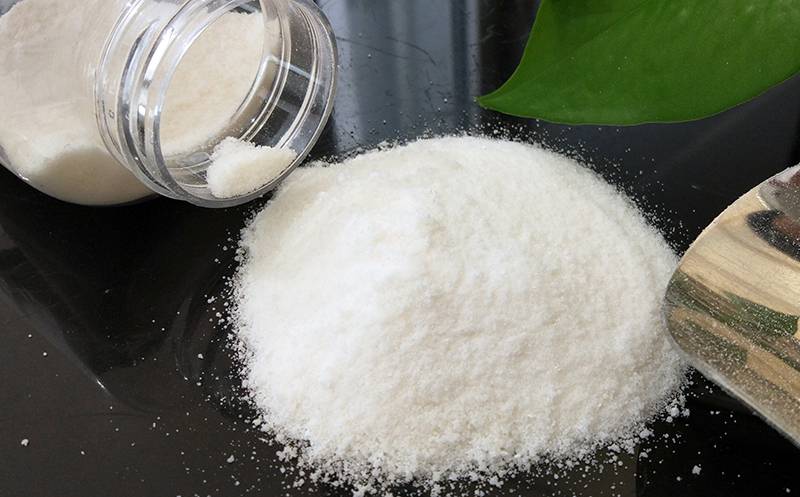
아크릴 바인더
경우에 따라 셀룰로오스/왁스 혼합물의 대안으로 아크릴 바인더를 사용할 수 있습니다. 그러나 아크릴 바인더는 시료와 균질화하기가 더 어려울 수 있으며, 분쇄 중에 자동으로 첨가되는 것이 아니라 수동으로 혼합해야 하는 경우가 많습니다. 이 경우 바인더가 시료 전체에 고르게 분포되지 않아 최종 펠릿에 불일치가 발생할 수 있습니다.
사전 혼합 펠릿
편의를 위해 일부 바인더는 분쇄 중에 자동으로 분쇄기에 추가할 수 있는 사전 혼합 펠릿으로 제공됩니다. 이러한 사전 혼합 펠릿은 바인더가 시료 전체에 고르게 분포되도록 하여 보다 일관되고 신뢰할 수 있는 결과를 얻을 수 있도록 합니다. 그러나 사전 혼합 펠릿의 선택은 분석 중인 특정 시료와 호환되는지 신중하게 고려해야 합니다.
가장 적합한 바인더 선택
주어진 시료에 가장 적합한 바인더를 선택하는 것은 시료의 유형, 원하는 펠릿 강도, 분석의 특정 요구 사항 등 여러 요인에 따라 달라집니다. 다음은 바인더를 선택할 때 염두에 두어야 할 몇 가지 주요 고려 사항입니다:
샘플 유형
시료마다 다른 유형의 바인더가 필요할 수 있습니다. 예를 들어, 분쇄하기 어렵거나 분쇄하기 어려운 상이 포함된 시료의 경우 시료와 더 잘 균질화되고 입자를 함께 고정할 수 있는 바인더를 사용하는 것이 도움이 될 수 있습니다. 이러한 경우 셀룰로오스/왁스 혼합물이 아크릴 바인더보다 더 효과적일 수 있습니다.
펠릿 강도
최종 펠릿의 강도는 또 다른 중요한 고려 사항입니다. 펠릿의 강도가 강할수록 취급 또는 분석 중에 파손될 가능성이 적어 오염의 위험이 줄어들고 결과의 정확도가 향상됩니다. 일반적으로 셀룰로오스/왁스 혼합물은 강하고 안정적인 펠릿을 생성하는 능력 때문에 선호됩니다.
분석 요구 사항
사용 중인 분광기의 유형이나 측정 감도와 같은 분석의 특정 요구 사항도 바인더 선택에 영향을 미칠 수 있습니다. 예를 들어, 일부 바인더는 고해상도 분석에 더 적합한 균일한 펠릿을 생성하는 반면, 다른 바인더는 오염을 방지하는 데 더 효과적일 수 있습니다.
바인더 선택 모범 사례
최상의 결과를 얻으려면 바인더를 선택하고 사용할 때 모범 사례를 따르는 것이 중요합니다. 다음은 바인더를 최대한 활용하는 데 도움이 되는 몇 가지 팁입니다:
여러 바인더 테스트하기
가능하면 샘플로 여러 바인더를 테스트하여 가장 일관되고 신뢰할 수 있는 결과를 생성하는 바인더를 결정하세요. 이렇게 하면 특정 애플리케이션에 가장 적합한 바인더를 식별하는 데 도움이 될 수 있습니다.
비율에 주의
균일한 펠렛을 얻으려면 샘플과 바인더의 비율이 중요합니다. 바인더를 너무 많이 첨가하면 펠릿이 너무 단단하고 부서지기 쉬우며, 너무 적게 첨가하면 약하고 불안정한 펠릿이 될 수 있습니다. 일반적으로 시료 대비 바인더의 비율은 20~30%가 권장되지만, 특정 바인더와 시료에 따라 달라질 수 있습니다.
고른 분포 보장
사용된 바인더의 유형에 관계없이 바인더가 시료 전체에 고르게 분포되도록 하는 것이 중요합니다. 이는 바인더를 샘플과 조심스럽게 혼합하거나 미리 혼합된 펠릿을 사용하여 달성할 수 있습니다. 바인더의 분포가 고르지 않으면 최종 펠릿에 불일치가 발생하여 분석의 정확도에 영향을 미칠 수 있습니다.
입자 크기 모니터링
시료의 입자 크기도 바인더의 효과에 영향을 미칠 수 있습니다. 입자 크기가 클수록 바인더가 모든 입자를 효과적으로 결합하지 못할 수 있으므로 균질하지 않은 펠릿이 생성될 수 있습니다. 샘플을 일정한 입자 크기로 분쇄하면 바인더의 성능을 개선하고 보다 균일한 펠릿을 생성하는 데 도움이 될 수 있습니다.
결론
바인더의 선택은 분석을 위한 균질하고 안정적인 펠릿을 준비하는 데 있어 매우 중요한 요소입니다. 시료에 가장 적합한 바인더를 선택하고 사용 모범 사례를 따르면 일관성 있고 신뢰할 수 있으며 오염이 없는 펠릿을 얻을 수 있습니다. 셀룰로오스/왁스 혼합물, 아크릴 바인더 또는 사전 혼합 펠릿을 선택하든 위에서 설명한 요소를 신중하게 고려하면 분석에서 최상의 결과를 얻는 데 도움이 됩니다.
펠릿 두께: 충분한 샘플링 깊이 확보
X선 형광(XRF) 분석에서 압축된 펠릿의 두께는 분석 결과의 정확성과 신뢰성에 직접적인 영향을 미치는 중요한 요소입니다. 펠릿은 샘플에서 생성된 X선이 재흡수되지 않고 빠져나갈 수 있을 만큼 충분히 두꺼워야 존재하는 원소를 정밀하게 측정할 수 있습니다. 이 섹션에서는 펠릿 두께의 중요성, 필요한 두께를 계산하는 방법, 부정확한 결과를 초래할 수 있는 일반적인 실수에 대해 자세히 설명합니다.
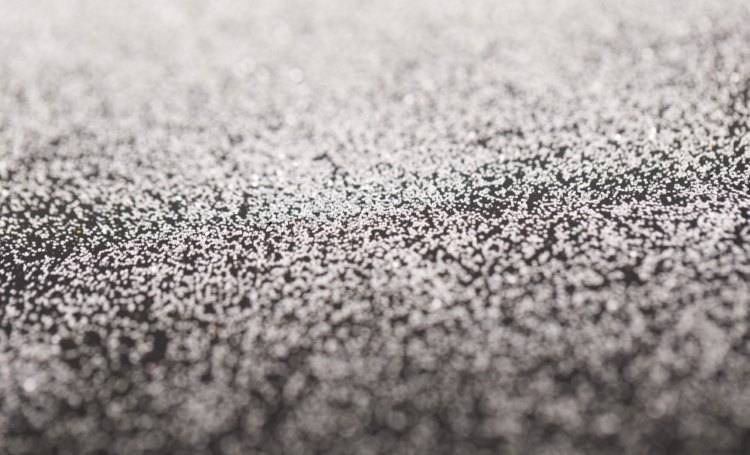
펠릿 두께의 중요성
XRF 분석을 위해 압축 펠릿을 준비할 때 가장 중요한 것은 측정하는 모든 원소에 대해 펠릿이 X-선 빔에 대해 "무한히 두꺼운" 두께인지 확인하는 것입니다. 즉, 펠릿 두께가 시료에서 가장 에너지가 높은 원소의 방출 깊이를 초과해야 합니다. 펠릿이 너무 얇으면 시료에서 생성된 X-선이 검출기에 도달하기 전에 재흡수되어 원소의 농도가 과소평가될 수 있습니다.
원소의 탈출 깊이는 에너지 레벨에 따라 달라지며, 일반적으로 에너지가 높은 원소일수록 탈출 깊이가 더 깊습니다. 예를 들어 원자 번호가 높은 원소(예: 철, 구리)는 에너지가 낮은 원소(예: 나트륨, 마그네슘)에 비해 탈출 깊이가 더 깊습니다. 따라서 펠릿은 관심 있는 원소의 가장 깊은 탈출 깊이를 수용할 수 있을 만큼 충분히 두꺼워야 합니다.
필요한 펠릿 두께 계산
필요한 펠릿 두께를 결정하려면 시료에서 가장 에너지가 높은 원소의 탈출 깊이를 고려해야 합니다. 이스케이프 깊이는 시료에 존재하는 원소의 질량 흡수 계수를 사용하여 계산할 수 있습니다. 질량 흡수 계수는 물질이 X-선을 얼마나 흡수할 수 있는지를 측정하는 척도로, 원소의 원자 번호와 X-선의 에너지에 따라 달라집니다.
실용적인 목적을 위해 직경 32mm 펠릿의 경우 8-10그램의 샘플로 만든 펠릿, 직경 40mm 펠릿의 경우 13-15그램의 샘플이면 현재 사용 가능한 가장 강력한 파장 분산형 X-선 형광(WDXRF) 기기로도 측정할 수 있는 원소에 대해 일반적으로 충분합니다. 이러한 무게는 펠릿이 X-선의 재흡수를 방지하고 정확한 분석 결과를 제공할 수 있을 만큼 충분히 두꺼워지도록 합니다.
펠릿 두께에 대한 일반적인 실수
프레스 펠릿을 준비할 때 가장 흔한 실수 중 하나는 필요한 두께를 과소평가하는 것입니다. 이는 펠릿이 측정 대상 요소의 가장 깊은 탈출 깊이를 수용할 만큼 충분히 두껍지 않은 경우 발생할 수 있습니다. 그 결과 시료에서 생성된 X-선이 재흡수되어 부정확한 측정이 발생할 수 있습니다.
또 다른 일반적인 오류는 시료의 평균 원자 질량을 고려하지 못하는 것입니다. 시료의 흡수 능력은 평균 원자 질량에 정비례하므로 무거운 원소가 가벼운 원소보다 더 많은 X선을 흡수합니다. 따라서 필요한 펠릿 두께를 결정할 때 시료의 평균 원소 구성을 고려하는 것이 중요합니다.
오염 고려 사항
펠릿 두께 외에도 오염은 XRF 분석의 품질에 영향을 미칠 수 있는 또 다른 중요한 요소입니다. 오염은 시료 분쇄 과정에서 발생할 수 있으며 시료 전처리 장치 또는 시료 간 교차 오염에서 비롯될 수 있습니다. 오염을 최소화하려면 깨끗한 장비를 사용하고 시료 준비 과정이 통제된 환경에서 수행되는지 확인하는 것이 필수적입니다.
펠렛 준비 모범 사례
정확하고 신뢰할 수 있는 XRF 분석을 보장하려면 펠릿 준비 모범 사례를 따르는 것이 중요합니다. 여기에는 필요한 펠릿 두께를 얻기 위해 적절한 양의 시료를 사용하고, 올바른 바인더를 선택하고, 압착 공정 중에 일관된 압력을 가하는 것이 포함됩니다. 준비 과정의 세부 사항과 일관성에 대한 주의는 오류를 최소화하고 고품질 분석 결과를 얻기 위한 핵심입니다.
요약하면, 압축된 펠릿의 두께는 분석 결과의 정확성과 신뢰성에 직접적인 영향을 미치는 XRF 분석에서 매우 중요한 요소입니다. 펠릿의 두께가 측정 대상 원소의 가장 깊은 탈출 깊이를 수용하기에 충분한지 확인하고 펠릿 준비 모범 사례를 준수함으로써 분석가는 시료에 존재하는 원소를 정밀하고 정확하게 측정할 수 있습니다.
압력 적용: 압축과 균질성의 균형 맞추기
펠릿을 압축하는 동안 최적의 압력을 달성하는 것은 공극이 없고 일관된 특성을 나타내는 고품질 펠릿을 만드는 데 매우 중요합니다. 이 공정에는 적절한 압력을 가해 샘플을 압축하고 바인더를 재결정화하여 최종 제품이 밀도가 높고 균질한지 확인하는 과정이 포함됩니다. 이 섹션에서는 과압 및 부족 압력의 영향과 시료에 대한 최적의 압력을 얻기 위한 기술을 포함하여 압력 적용의 중요한 측면에 대해 자세히 설명합니다.
적절한 압력 적용의 중요성
펠릿 프레싱의 주요 목표는 시료의 광도에 큰 영향을 미칠 수 있는 펠릿 내부의 빈 공간을 제거하는 것입니다. 잘 압축된 펠릿은 내부 공극을 방지할 수 있을 만큼 밀도가 높아야 샘플과 바인더가 균일하게 분포할 수 있습니다. 이를 위해서는 시료를 완전히 압축하고 바인더를 재결정화할 수 있는 충분한 압력을 가하는 것이 필수적입니다.
실험 및 최적의 압력 범위
특정 시료에 대한 최적의 압력을 찾으려면 실험이 필요합니다. 먼저 시료에 압력을 높여가며 더 가벼운 요소의 강도를 관찰하세요. 대부분의 시료는 1~2분 동안 25~35미터톤(T) 사이의 압력에서 최대 강도에 도달합니다. 이 범위는 좋은 시작점이지만 개별 시료의 특정 특성에 따라 조정이 필요할 수 있습니다.
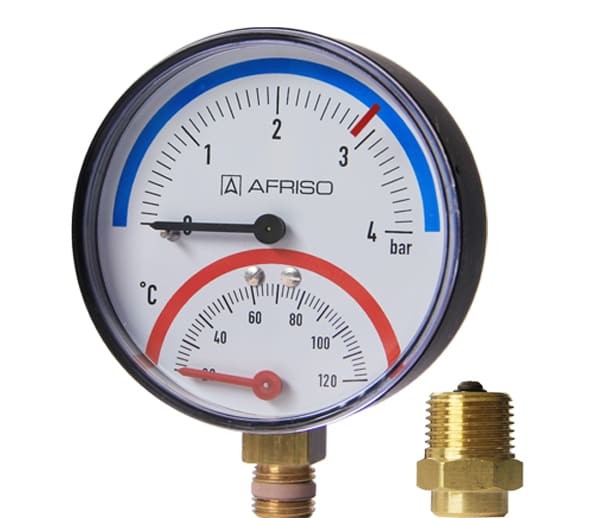
과압 및 저압 피하기
과도하게 누르면 압축의 파단 강도를 초과하여 균열이 발생하거나 펠릿의 윗부분이 나머지 부분에서 분리되는 '캡핑'이 발생하는 등 여러 가지 문제가 발생할 수 있습니다. 매우 높은 힘을 가한다고 해서 반드시 더 좋은 펠릿이 만들어지는 것은 아니며 득보다 실이 많을 수 있습니다. 반면에 압력이 약하면 펠릿 내에 빈 공간이 생겨 결과가 일관되지 않고 가벼운 요소의 강도가 낮아질 수 있습니다.
최적의 압력 적용을 위한 기술
-
느린 압력 방출: 필요한 압력을 가한 후 펠릿 표면의 균열을 방지하기 위해 천천히 압력을 해제합니다. 압력을 빠르게 해제하면 응력 골절이 발생하여 펠릿의 무결성이 손상될 수 있습니다.
-
다이 정렬 및 로딩: 프레스와 다이가 균일한 압력을 가할 수 있도록 올바르게 정렬되었는지 확인합니다. 다이 슬리브에 파우더를 과도하게 채우면 압축이 고르지 않을 수 있으므로 피해야 합니다. 용량을 초과하지 않도록 강재의 항복 강도의 50% 이하로 다이를 로드합니다.
-
펠렛 치수: 펠릿의 높이와 지름 사이의 균형 잡힌 비율을 유지합니다. 직경보다 훨씬 긴 펠릿은 상단 플런저 근처에서 더 큰 응력이 발생하여 균열이 발생할 수 있습니다. 더 긴 펠릿을 누르는 경우, 더 낮은 힘을 사용하고, 다이에 윤활유를 바르고, 베이스 플레이트와 슬리브 사이에 오링을 사용하여 응력을 더 고르게 분산시키는 것이 좋습니다.
-
고른 파우더 분포: 시료 혼합물을 다이 캐비티로 옮길 때 고르게 퍼지도록 하십시오. 고르지 않은 분포는 일관되지 않은 압축과 펠릿 내부의 공극을 초래할 수 있습니다.
압력 적용을 위한 실용적인 단계
- 펠릿 프레스 고정: 다이를 프레스 캐비티에 고정하고 올바르게 정렬되었는지 확인합니다.
- 샘플 전송: 금속 주걱을 사용하여 분쇄된 샘플 혼합물을 다이 캐비티에 고르게 펴 바릅니다.
- 입자 분배: 볼트 프레스를 삽입하고 회전하여 입자가 고르게 분포되도록 합니다.
- 다이 세트 고정: 다이 세트를 유압식 펠릿 프레스로 옮기고 휠을 돌려 단단히 고정합니다.
- 압력 가하기: 유압 프레스의 밸브를 닫고 레벨을 당겨 손잡이가 꽉 조여질 때까지 압력을 가합니다.
- 압력 해제: 다이를 해제하려면 먼저 압력을 풀고 프레스의 상단 휠을 위로 이동한 다음 마지막으로 다이를 꺼냅니다.
압축과 균질성의 균형을 신중하게 조정하면 실험 요구 사항을 충족하는 고품질 펠릿을 얻을 수 있습니다. 적절한 압력 적용과 공정의 각 단계에서 세심한 주의를 기울이면 펠릿의 밀도가 높고, 공극이 없으며, 특성이 일관된 펠릿을 얻을 수 있습니다.
희석 비율: 정확한 결과를 위한 미세 조정
희석 비율은 X-선 형광(XRF) 분석에서 중요한 역할을 하며 결과의 정확성과 신뢰성에 영향을 미칩니다. 적절한 희석 비율을 적절히 결정하고 적용하는 것은 시료 준비 및 매트릭스 효과와 관련된 일반적인 문제를 완화하여 시료의 원소 조성을 정확하게 나타내도록 하는 데 필수적입니다.
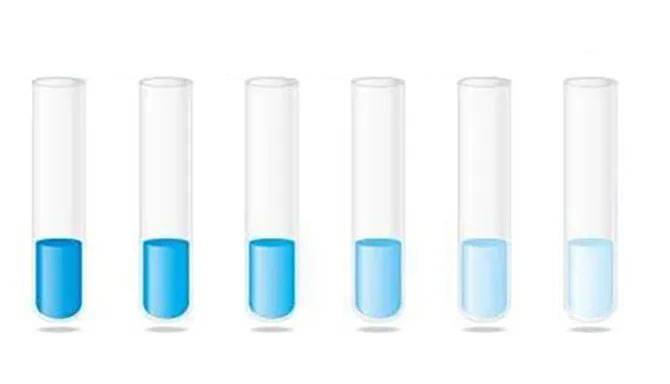
희석 비율이 XRF 분석에 미치는 영향
XRF 분석에서 희석 비율은 시료에서 방출되는 X-선 선의 강도에 직접적인 영향을 미칩니다. 희석 비율을 잘 선택하면 측정된 강도를 왜곡할 수 있는 흡수 및 강화와 같은 매트릭스 효과의 균형을 맞출 수 있습니다. 흡수는 시료의 원소가 다른 원소에서 방출되는 X-선을 흡수하여 검출기에 도달하는 X-선의 강도를 감소시킬 때 발생합니다. 반면에 강화는 시료에 고에너지 원소가 존재할 때 분석 대상 원소의 원자가 여기되어 X-선 선의 강도가 높아질 때 발생합니다.
희석 비율을 신중하게 선택하면 이러한 매트릭스 효과를 최소화하여 보다 정확하고 재현 가능한 결과를 얻을 수 있습니다. 적절한 희석 비율은 샘플이 너무 농축되어 과도한 흡수가 일어나거나 너무 희석되어 신호 강도가 약해져 정확한 측정이 어려워지지 않도록 보장합니다.
적절한 희석 비율 결정하기
적절한 희석 비율을 결정하려면 이론적 고려 사항과 실제 실험을 조합하여 결정해야 합니다. 목표는 시료가 매트릭스 재료 전체에 고르게 분포된 균질한 혼합물을 얻는 것입니다. 다음은 따라야 할 몇 가지 주요 단계입니다:
-
샘플 구성 이해: 시료의 원소 구성을 철저히 이해하는 것부터 시작하세요. 여기에는 존재하는 주요 원소, 미량 원소 및 미량 원소의 농도를 아는 것이 포함됩니다. 이 정보는 잠재적인 매트릭스 효과를 예측하는 데 매우 중요합니다.
-
적합한 매트릭스 재료 선택: 매트릭스 재료는 화학적으로 불활성이어야 하며 흡수 및 강화 효과를 최소화하는 조성을 가져야 합니다. 일반적으로 사붕산 리튬(LiBO₂)과 붕산(H₃BO₃)이 선택되며, 이는 다양한 시료 유형과 안정적이고 균일한 혼합물을 형성할 수 있는 것으로 잘 알려져 있습니다.
-
예비 희석 수행: 다양한 희석 비율로 시작하여 결과 강도를 측정합니다. 이 측정값을 사용하여 다양한 비율이 엑스레이 선의 강도에 미치는 영향을 평가합니다. 강도가 안정적이고 매트릭스 효과가 최소화되는 비율을 찾습니다.
-
균질성을 위한 최적화: 샘플이 75µm 미만의 입자 크기로 미세하게 분쇄되었는지 확인합니다. 이는 균일한 혼합물을 얻기 위해 필수적이며, 이는 정확한 XRF 분석에 매우 중요합니다. 입자가 미세할수록 혼합물의 품질이 향상되어 최종 펠릿에서 공극과 고르지 않은 표면이 발생할 가능성이 줄어듭니다.
-
안정성 및 재현성 평가: 적절한 희석 비율이 확인되면 안정성과 재현성을 보장하기 위해 여러 번 측정합니다. 결과의 변화는 불완전한 혼합 또는 입자 크기 변화와 같은 시료 준비 과정에 문제가 있음을 나타낼 수 있습니다.
부적절한 희석과 관련된 일반적인 문제
부적절한 희석은 XRF 분석에서 몇 가지 일반적인 문제를 일으킬 수 있습니다:
-
과도한 흡수: 시료가 과도하게 농축되면 시료에서 방출되는 X선이 시료의 다른 원소에 의해 크게 흡수되는 과도한 흡수가 발생할 수 있습니다. 이로 인해 특정 원소의 농도가 과소평가될 수 있습니다.
-
약한 신호 강도: 반대로 농도가 낮은 시료는 신호 강도가 약해져 정확한 측정값을 얻기가 어려울 수 있습니다. 이는 미량 원소의 경우 특히 문제가 되는데, 안정적으로 감지할 수 있을 만큼 강한 신호를 생성하지 못할 수 있습니다.
-
매트릭스 효과: 부적절한 희석은 흡수 및 강화와 같은 매트릭스 효과를 악화시킬 수 있습니다. 이러한 효과는 측정된 강도를 왜곡하여 부정확한 결과를 초래할 수 있습니다.
-
불균일 혼합물: 시료가 미세하게 분쇄되지 않았거나 희석 비율이 최적화되지 않은 경우 결과 혼합물이 불균일할 수 있습니다. 이로 인해 동일한 시료 내에서도 측정된 강도가 달라져 결과의 신뢰도가 떨어질 수 있습니다.
결론
희석 비율을 미세 조정하는 것은 정확하고 신뢰할 수 있는 XRF 분석 결과를 얻기 위한 중요한 단계입니다. 적절한 희석 비율을 신중하게 선택하고 균일한 혼합물을 보장함으로써 매트릭스 효과 및 시료 준비와 관련된 기타 일반적인 문제를 최소화할 수 있습니다. 이 접근 방식은 측정의 정확성을 향상시킬 뿐만 아니라 결과의 재현성을 향상시켜 다양한 시료와 실험에서 데이터를 더 쉽게 비교할 수 있게 해줍니다.
샘플 간 교차 오염: 간섭 방지
샘플 간 교차 오염은 분석 실험실에서 매우 중요한 문제로, 잠재적으로 부정확한 결과와 데이터 무결성 손상으로 이어질 수 있습니다. 이 섹션에서는 교차 오염을 최소화하는 방법, 세척 프로토콜의 중요성, 샘플 순도 보장을 위한 모범 사례에 대해 자세히 설명합니다.
교차 오염에 대한 이해
교차 오염은 한 샘플의 잔류물이 다른 샘플의 분석을 방해하여 왜곡된 결과를 초래할 때 발생합니다. 이는 시료의 다양성에 따라 오염의 위험이 증가하기 때문에 다양한 시료 유형을 분석하는 환경에서 특히 문제가 됩니다. 예를 들어, 분쇄기와 같은 시료 전처리 장치를 사용 사이에 철저히 세척하지 않으면 한 시료의 성분이 다른 시료로 유입되어 분석이 왜곡될 수 있습니다.

교차 오염을 최소화하는 방법
-
전용 장비 사용: 교차 오염을 최소화하는 효과적인 방법 중 하나는 특정 유형의 시료에 전용 장비를 사용하는 것입니다. 이렇게 하면 한 유형의 시료에서 나온 잔류물이 다른 유형의 시료를 방해하지 않도록 할 수 있습니다. 예를 들어, 금속 시료 전용 분쇄기는 비금속 시료에 금속 원소가 유입되는 것을 방지할 수 있습니다.
-
철저한 세척 프로토콜: 엄격한 세척 프로토콜을 실행하는 것은 필수적입니다. 매번 사용 후에는 표준화된 절차에 따라 장비를 청소해야 합니다. 여기에는 적절한 용제 또는 세척제를 사용하고 모든 잔여물이 제거되었는지 확인하는 것이 포함됩니다. 예를 들어, 강철 분쇄 용기는 철, 니켈, 크롬 잔류물을 용해할 수 있는 용매로 세척해야 합니다.
-
시료 준비 기술: 시료 준비에 사용되는 기술도 교차 오염의 위험에 영향을 미칠 수 있습니다. 예를 들어, XRF 분석을 위한 교정 표준을 준비할 때, 교정 표준의 매트릭스를 시료의 매트릭스와 일치시키는 것이 중요합니다. 이는 정확도를 향상시키고 오염 위험을 줄이는 데 도움이 됩니다. 또한 분석 증명서가 있는 고품질 교정 블랭크를 사용하면 교정 프로세스의 무결성에 대한 확신을 가질 수 있습니다.
-
샘플 홀더 사용: 작고 얇은 시료의 경우 시료 홀더를 사용하면 시료 뒤에 있는 물체의 간섭을 방지할 수 있습니다. 이렇게 하면 시료와 분광기의 검출 창 사이의 거리를 일정하게 유지하여 보다 정확한 분석이 가능합니다.
-
다중 표면 측정: 대형 금속 샘플을 테스트할 때는 보다 정확한 결과를 얻기 위해 여러 표면을 여러 번 측정하는 것이 좋습니다. 이렇게 하면 단일 표면의 국부적인 오염으로 인한 왜곡된 데이터의 가능성을 줄일 수 있습니다.
청소 프로토콜의 중요성
세척 프로토콜은 교차 오염을 방지하는 중추입니다. 세척 프로토콜은 장비에 후속 분석을 방해할 수 있는 잔여물이 없도록 보장합니다. 정기적인 유지보수와 시동 및 종료에 대한 표준 운영 절차(SOP)를 준수하는 것이 중요합니다. 예를 들어, 기기가 예상대로 작동하는지 확인하기 위해 자주 점검하면 오염으로 이어질 수 있는 문제를 예방할 수 있습니다.
샘플 준비 모범 사례
샘플 준비의 주요 목표는 샘플의 균질성을 보장하고 샘플의 원래 형태에서 발생할 수 있는 잠재적인 간섭을 관리하는 것입니다. 속도와 한 번에 준비할 수 있는 샘플 수 측면에서 이점을 제공하는 기술은 처리량이 많은 실험실에서 특히 유용합니다. 그러나 속도와 정확성 및 무결성의 필요성 사이에서 균형을 맞추는 것이 중요합니다.
결론
시료 간 교차 오염을 방지하는 것은 분석 결과의 정확성과 신뢰성을 유지하는 데 필수적입니다. 전용 장비, 엄격한 세척 프로토콜, 샘플 준비 모범 사례를 구현함으로써 실험실은 오염의 위험을 크게 줄일 수 있습니다. 이는 개별 분석의 무결성을 보장할 뿐만 아니라 실험실 데이터의 전반적인 신뢰성에도 기여합니다.
XRF 펠릿 준비 시 오류 감소를 위한 모범 사례
X선 형광(XRF) 분석의 경우, 결과의 품질은 샘플 준비에 따라 크게 달라집니다. XRF 분석을 위해 압축된 펠릿을 만드는 과정은 데이터의 정확성과 신뢰성에 큰 영향을 미칠 수 있는 중요한 단계입니다. 오류를 최소화하고 일관된 결과를 보장하려면 XRF 펠릿 준비의 모범 사례를 따르는 것이 필수적입니다. 이 섹션에서는 분석법 개발, 세부 사항 주의 및 일관성을 위한 주요 전략에 대해 설명하여 XRF 시료 준비의 오류를 줄이도록 합니다.

분석법 개발
XRF 펠릿 준비에서 오류를 줄이기 위한 첫 번째 단계는 강력한 방법을 개발하는 것입니다. 여기에는 분석할 시료의 특정 요구 사항을 이해하고 그에 따라 준비 과정을 조정하는 것이 포함됩니다. XRF 분석을 위한 시료 유형의 범위는 방대하며, 각 시료에는 준비 방법을 조정해야 하는 고유한 특성이 있을 수 있습니다. 예를 들어 시료의 입자 크기, 바인더 선택, 희석 비율은 신중하게 고려해야 하는 중요한 요소입니다.
-
입자 크기: 시료의 입자 크기는 펠릿의 균질성에 큰 영향을 미치고 결과적으로 XRF 분석의 정확도에 영향을 미칠 수 있습니다. 일반적으로 펠릿 내에서 시료의 균일한 분포를 보장하기 위해 100마이크로미터 미만의 입자 크기를 사용하는 것이 좋습니다. 입자가 크면 이질성이 발생하여 판독값이 일관되지 않을 수 있습니다.
-
바인더 선택: 펠릿 준비 공정에 사용되는 바인더는 펠릿의 무결성과 안정성을 보장하는 데 중요한 역할을 합니다. 일반적인 바인더에는 붕산염 유리, 셀룰로오스 및 왁스가 포함됩니다. 바인더의 선택은 시료와의 호환성 및 XRF 분석의 특정 요구 사항을 기반으로 해야 합니다. 예를 들어, 일부 바인더는 분석을 방해할 수 있는 요소를 도입할 수 있으므로 이러한 간섭을 최소화하는 바인더를 선택하는 것이 중요합니다.
-
희석 비율: 희석 비율은 바인더에 대한 시료의 비율을 나타냅니다. 적절한 희석 비율은 시료가 펠릿 내에 고르게 분포되도록 하여 특정 원소가 과대 또는 과소 표현될 위험을 줄여줍니다. 최적의 희석 비율은 시료의 구성과 분석 요구 사항에 따라 달라집니다. 주어진 시료에 대한 최적의 희석 비율을 결정하기 위해 일련의 테스트를 수행해야 하는 경우가 많습니다.
세부 사항에 대한 주의
오류를 최소화하기 위해 XRF 펠릿 준비에서 가장 중요한 것은 세부 사항에 대한 주의입니다. 준비 과정의 작은 편차도 분석 결과에 큰 차이를 초래할 수 있습니다. 따라서 준비 과정의 모든 단계에서 일관성을 유지하는 것이 중요합니다.
-
압력 적용: 펠릿 프레스 공정에서 가해지는 압력의 양은 펠릿의 밀도와 균질성에 영향을 미치는 중요한 요소입니다. 압력이 충분하지 않으면 펠릿이 느슨해지고, 압력이 과도하면 시료가 고르지 않게 압축될 수 있습니다. 최적의 압력은 시료의 특성과 XRF 분석의 특정 요구 사항에 따라 결정해야 합니다. 재현 가능한 결과를 얻으려면 적용되는 압력의 일관성이 필수적입니다.
-
펠릿의 두께: 최종 펠릿의 두께는 XRF 분석의 감도와 정확도에 영향을 미칠 수 있습니다. 너무 얇은 펠릿은 충분한 신호를 제공하지 못할 수 있고, 너무 두꺼운 펠릿은 결과를 왜곡하는 흡수 효과로 이어질 수 있습니다. 이상적인 두께는 일반적으로 시료의 구성과 분석 요구 사항에 따라 1~3밀리미터 사이입니다.
-
시료 간 교차 오염: 시료 간 교차 오염은 XRF 분석에서 흔히 발생하는 오류의 원인입니다. 이러한 위험을 최소화하려면 시료 전처리 사이에 모든 장비와 표면을 철저히 세척하는 것이 필수적입니다. 여기에는 펠릿 프레스, 시료 용기 및 공정에 사용되는 기타 모든 도구가 포함됩니다. 또한 각 시료에 전용 도구를 사용하면 교차 오염의 위험을 더욱 줄일 수 있습니다.
일관성
준비 과정의 일관성은 XRF 분석의 오류를 줄이기 위한 핵심 요소입니다. 여기에는 표준 운영 절차(SOP)를 수립하고 정기적인 품질 관리(QC) 및 품질 보증(QA) 점검을 수행하는 것이 포함됩니다.
-
표준 운영 절차(SOP): SOP를 개발하고 준수하면 준비 과정의 모든 단계가 일관되게 수행될 수 있습니다. SOP에는 입자 크기, 바인더 선택, 희석 비율, 압력 적용, 펠릿 두께 등 시료 전처리에 대한 자세한 지침이 포함되어야 합니다. 준비 과정에 대한 정기적인 교육과 문서화는 모든 직원이 SOP를 일관되게 따르도록 하는 데 도움이 될 수 있습니다.
-
품질 관리(QC) 및 품질 보증(QA): QC 및 QA 절차는 XRF 분석의 정확성과 신뢰성을 모니터링하는 데 필수적입니다. 여기에는 결과의 정확성을 검증하기 위해 인증된 참조 물질(CRM), 블랭크, 복제본 및 복제본의 사용이 포함됩니다. 정기적인 QC 점검을 통해 예상 결과와의 편차를 파악하고 준비 과정을 적시에 조정할 수 있습니다.
-
매트릭스 매칭: 매트릭스 매칭은 매트릭스 효과를 최소화하기 위해 미지의 샘플과 유사한 구성의 샘플을 준비하는 것입니다. 이를 통해 흡수 또는 강화 효과와 같은 시료 조성의 차이로 인한 오류를 줄일 수 있습니다. 매트릭스 매칭은 다양한 조성을 가진 복잡한 시료를 분석할 때 특히 중요합니다.
결론
결론적으로, XRF 펠릿 준비에서 오류를 줄이려면 방법 개발, 세부 사항에 대한 주의, 일관성의 조합이 필요합니다. 입자 크기, 바인더 선택, 희석 비율, 압력 적용, 펠릿 두께와 같은 요소를 신중하게 고려하고 SOP를 수립하고 정기적인 QC 및 QA 점검을 수행하면 오류를 최소화하고 정확하고 신뢰할 수 있는 XRF 분석 결과를 보장할 수 있습니다. 작은 편차도 최종 결과에 큰 차이를 초래할 수 있기 때문에 성공적인 XRF 분석의 핵심은 시료의 세심한 준비에 있습니다.
결론: XRF 분석에서 정밀도 달성하기
정확한 결과를 얻으려면 펠렛 프레스 XRF 시료 준비 방법을 숙달하는 것이 중요합니다. 입자 크기, 오염, 바인더 선택, 펠릿 두께, 압력 적용, 희석 비율 및 교차 오염과 같은 일반적인 문제를 해결함으로써 XRF 분석의 정밀도를 크게 향상시킬 수 있습니다. 모범 사례를 준수하고 세부 사항에 세심한 주의를 기울이면 펠릿 준비의 모든 측면이 최적화되어 궁극적으로 신뢰할 수 있고 일관된 분석 결과를 얻을 수 있습니다. 준비 기술을 완성하는 데 시간을 투자하면 더 정확한 데이터와 시료에 대한 더 깊은 이해로 보상을 받을 수 있습니다.
관련 제품
- XRF 및 KBR 펠렛 프레스용 자동 실험실 유압 프레스
- FTIR용 XRF & KBR 플라스틱 링 실험실 분말 펠렛 프레스 몰드
- FTIR용 XRF & KBR 스틸 링 실험실 분말 펠릿 프레스 몰드
- 실험실용 XRF 붕산 분말 펠렛 프레스 몰드
- XRF KBR FTIR 실험실 응용 분야를 위한 실험실 유압 펠릿 프레스
